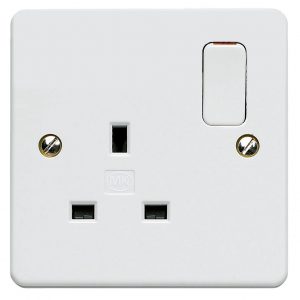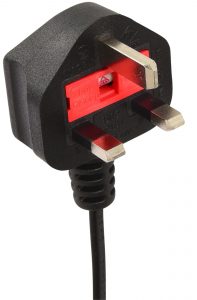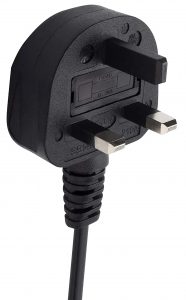TYPE G

 Type G is mainly used in the United Kingdom, Ireland, Cyprus, Malta, Malaysia, Singapore, Hong Kong and the Arabian Peninsula. (Click here for the full list of all countries that use type G)
Type G is mainly used in the United Kingdom, Ireland, Cyprus, Malta, Malaysia, Singapore, Hong Kong and the Arabian Peninsula. (Click here for the full list of all countries that use type G)
This 13 amp plug has three rectangular prongs that form an isosceles triangle. The central earth pin is 4 by 8 mm and 22.7 mm long. Line and neutral pins are 4 by 6.35 mm and 17.7 mm long, on centres spaced 22.2 mm apart. The centre-to-centre distance between the earth pin and the middle of the imaginary line connecting the two power pins is 22.2 mm. Or, simply put: the earth pin is offset by 22.2 mm. The 9-mm long insulated sleeves prevent accidental contact with a bare connector while the plug is partially inserted.
British Standard BS 1363 requires use of a three-wire grounded and fused plug for all connections to the power mains. Two-wire class II appliances are not earthed and often have a plastic grounding pin which only serves to open the shutters of the outlet. The lack of such an earth pin on a type C plug makes it impossible to connect it to a type G receptacle, although it can actually be forced into the socket by sticking a pointy object into the centre hole of the power outlet, which opens up the two other holes. Just to be perfectly clear, this is not a piece of advice; it's simply an observation...




